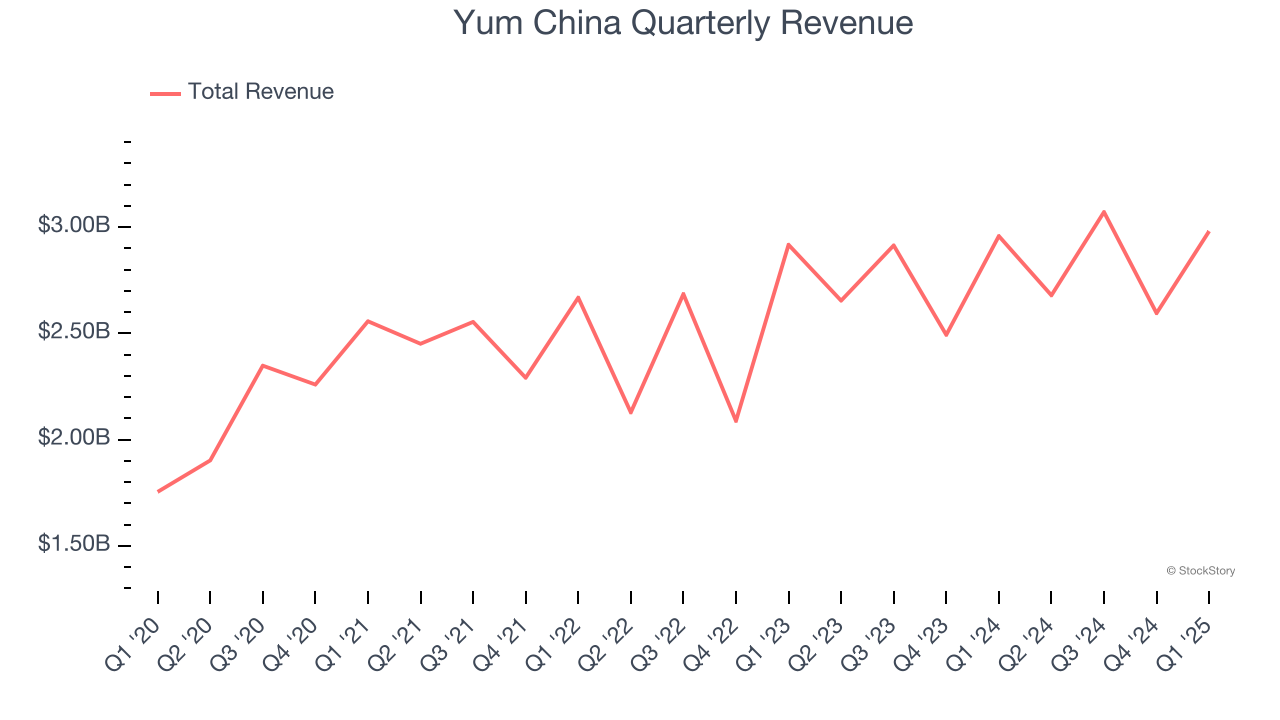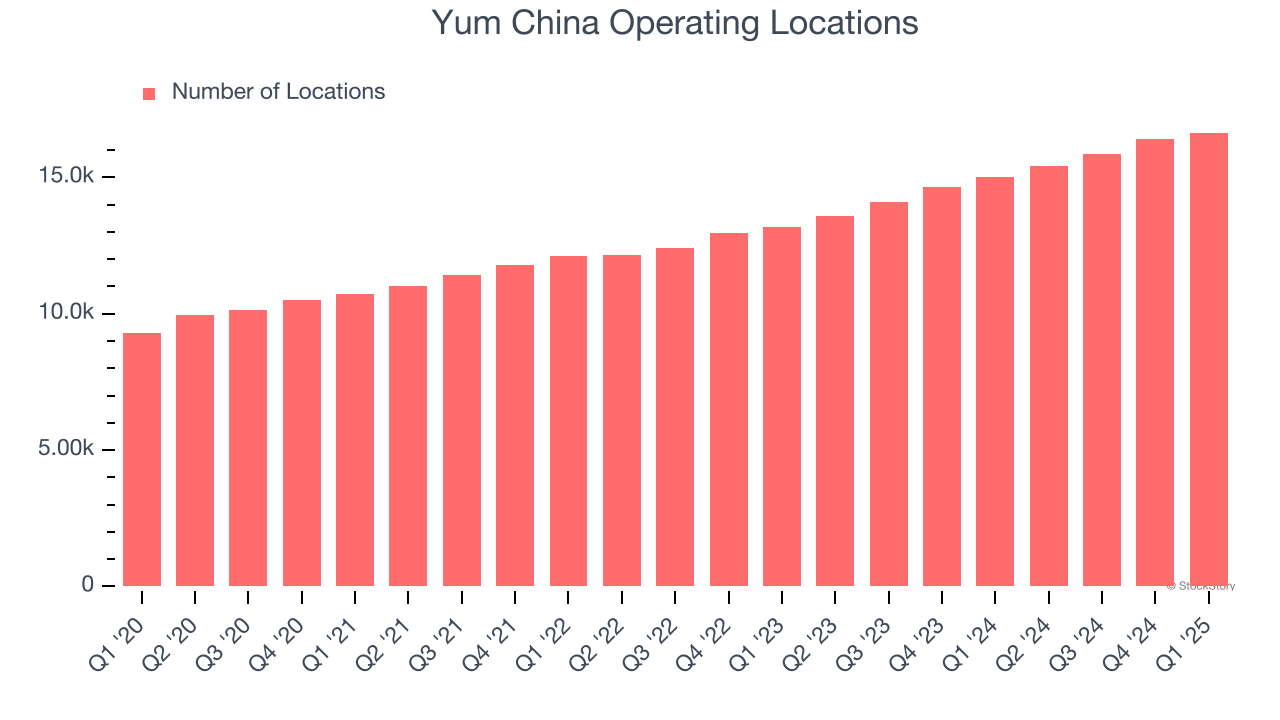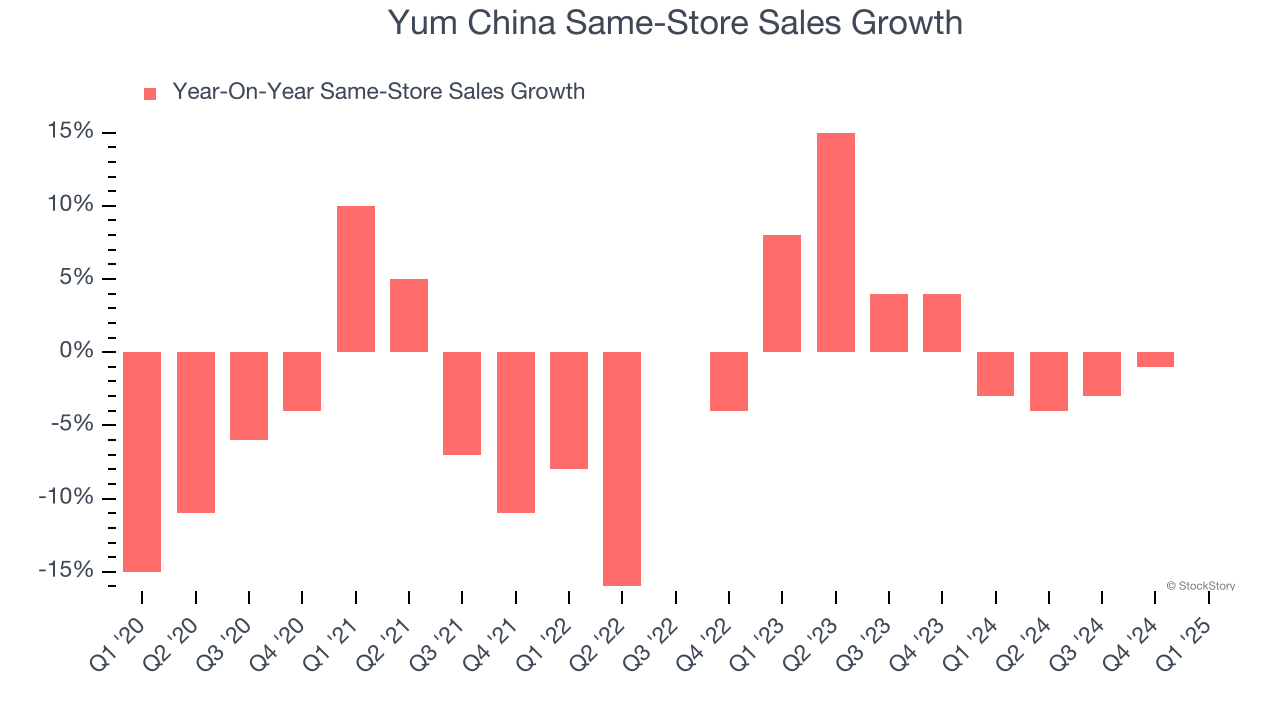
Fast-food company Yum China (NYSE: YUMC) missed Wall Street’s revenue expectations in Q1 CY2025, with sales flat year on year at $2.98 billion. Its non-GAAP profit of $0.77 per share was 1.5% below analysts’ consensus estimates.
Is now the time to buy Yum China? Find out by accessing our full research report, it’s free.
Yum China (YUMC) Q1 CY2025 Highlights:
- Revenue: $2.98 billion vs analyst estimates of $3.10 billion (flat year on year, 3.7% miss)
- Adjusted EPS: $0.77 vs analyst expectations of $0.78 (1.5% miss)
- Adjusted EBITDA: $514 million vs analyst estimates of $538.7 million (17.2% margin, 4.6% miss)
- Operating Margin: 13.4%, in line with the same quarter last year
- Free Cash Flow Margin: 10.6%, up from 8.6% in the same quarter last year
- Locations: 16,642 at quarter end, up from 15,022 in the same quarter last year
- Same-Store Sales were flat year on year (-3% in the same quarter last year)
- Market Capitalization: $17.39 billion
Total system sales grew 2% year over year ("YoY"), excluding foreign currency translation ("F/X").
Company Overview
One of China’s largest restaurant companies, Yum China (NYSE: YUMC) is an independent entity spun off from Yum! Brands in 2016.
Sales Growth
A company’s long-term sales performance can indicate its overall quality. Even a bad business can shine for one or two quarters, but a top-tier one grows for years.
With $11.33 billion in revenue over the past 12 months, Yum China is one of the most widely recognized restaurant chains and benefits from customer loyalty, a luxury many don’t have. Its scale also gives it negotiating leverage with suppliers, enabling it to source its ingredients at a lower cost. However, its scale is a double-edged sword because there is only so much real estate to build restaurants, placing a ceiling on its growth. To expand meaningfully, Yum China likely needs to tweak its prices, start new chains, or enter new markets.
As you can see below, Yum China’s sales grew at a sluggish 4.9% compounded annual growth rate over the last six years (we compare to 2019 to normalize for COVID-19 impacts) as it barely increased sales at existing, established dining locations.

This quarter, Yum China’s $2.98 billion of revenue was flat year on year, falling short of Wall Street’s estimates.
Looking ahead, sell-side analysts expect revenue to grow 6.7% over the next 12 months. While this projection implies its newer menu offerings will fuel better top-line performance, it is still below the sector average.
Here at StockStory, we certainly understand the potential of thematic investing. Diverse winners from Microsoft (MSFT) to Alphabet (GOOG), Coca-Cola (KO) to Monster Beverage (MNST) could all have been identified as promising growth stories with a megatrend driving the growth. So, in that spirit, we’ve identified a relatively under-the-radar profitable growth stock benefiting from the rise of AI, available to you FREE via this link.
Restaurant Performance
Number of Restaurants
Yum China sported 16,642 locations in the latest quarter. Over the last two years, it has opened new restaurants at a rapid clip by averaging 12.6% annual growth, among the fastest in the restaurant sector.
When a chain opens new restaurants, it usually means it’s investing for growth because there’s healthy demand for its meals and there are markets where its concepts have few or no locations.

Same-Store Sales
The change in a company's restaurant base only tells one side of the story. The other is the performance of its existing locations, which informs management teams whether they should expand or downsize their physical footprints. Same-store sales gives us insight into this topic because it measures organic growth at restaurants open for at least a year.
Yum China’s demand within its existing dining locations has been relatively stable over the last two years but was below most restaurant chains. On average, the company’s same-store sales have grown by 1.5% per year. This performance suggests it should consider improving its foot traffic and efficiency before expanding its restaurant base.

In the latest quarter, Yum China’s year on year same-store sales were flat. This was a meaningful deceleration from its historical levels. We’ll be watching closely to see if Yum China can reaccelerate growth.
Key Takeaways from Yum China’s Q1 Results
It was good to see Yum China meet analysts’ same-store sales expectations this quarter. On the other hand, its revenue missed significantly and its EBITDA fell short of Wall Street’s estimates. Overall, this was a softer quarter. The stock traded down 1.4% to $46.02 immediately after reporting.
Yum China’s latest earnings report disappointed. One quarter doesn’t define a company’s quality, so let’s explore whether the stock is a buy at the current price. The latest quarter does matter, but not nearly as much as longer-term fundamentals and valuation, when deciding if the stock is a buy. We cover that in our actionable full research report which you can read here, it’s free.

